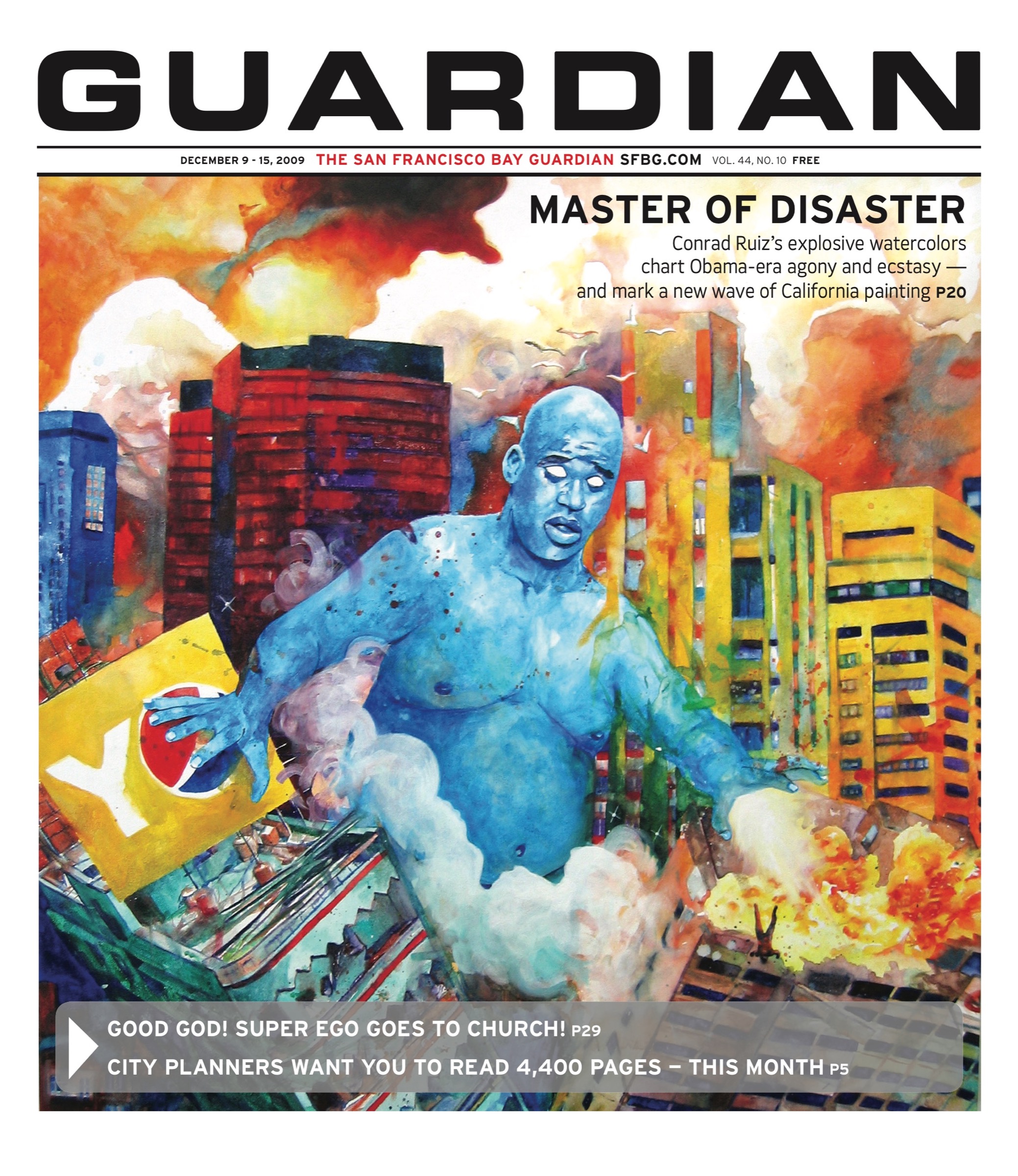news@sfbg.com
In the back room of Tommy’s Joynt, more than a dozen members of the antiwar group Code Pink gathered Dec. 1 to watch television coverage of President Barack Obama’s speech announcing that 30,000 more U.S. troops would be sent to fight in Afghanistan, his second major escalation of that war this year.
“This is not the hope you voted for!” read a flyer distributed at the event.
Yet even among Code Pink’s militant members, reactions ranged from feeling disappointed and betrayed to feeling validated in never believing Obama was the agent of change that he pretended to be.
Jennifer Teguia seemed an example of former, while Cecile Pineda embodied the latter. “Right down the line, it’s been the corporate line,” Pineda told us, citing as examples Obama’s support for Wall Street bailouts and insiders and his abandonment of single-payer health reform in favor of an insurance-based system. “For serious politicos, hope is a fantasy.”
Throughout the speech, Pineda let out audible groans at Obama lines such as “We did not ask for this fight” and “A place that had known decades of fear now has reason to hope.” When the president promised a quick exit date, Pineda labeled it “the old in and out.” And when Obama made one too many references to 9/11, she blurted out, “Ha! 9/11!” and “He sounds just like Bush!”
But Teguia just looked saddened by the speech, and maybe a little weary that after nearly eight years of fruitlessly fighting Bush’s wars, the movement will now need to reignite to resist Obama’s escalation, which will put more U.S. troops in Iraq and Afghanistan than Bush ever deployed.
“People are feeling tired and overwhelmed. We’ve been doing this year after year, and it’s endless. People are feeling dispirited,” Teguia told me just before the speech began.
She and other Obama supporters were willing to be patient and hopeful that Obama would eventually make good on his progressive campaign rhetoric. “But people are starting to feel like this window is closing,” Teguia said. “Now it’s at the tipping point.”
Obama has always tried to walk a fine line between his progressive ideals and his more pragmatic, centrist governing style. But in a conservative and often jingoistic country, Obama’s “center” isn’t where the antiwar movement thinks it ought to be.
“Obama is trying to unite the establishment instead of uniting the people against the establishment,” Teguia said.
That grim perspective was voiced by everyone in the room.
“Not only is he not clearing up the mess in Iraq, he’s escautf8g in Afghanistan,” said Rae Abileah, a Code Pink staff member who coordinates local campaigns. “I think people are outraged and frustrated and they’ve had enough.”
Perhaps, but the antiwar movement just isn’t what it was in 2003, when it shut down San Francisco on the first full day of war in Iraq. And the fact that Obama is a Democrat who opposed the Iraq War presents a real challenge for those who don’t support his Afghanistan policy and fear that it will be a disaster.
Democratic dilemma
Obama’s announcement — more then anything Bush ever said or did — is dividing the Democratic Party establishment, and the epicenter of that division is in San Francisco.
Rep. Nancy Pelosi is the Speaker of the House, second in command of the Democratic Party, essentially the person most responsible for the success or failure of a Democratic president’s agenda in Congress. She also represents a city where antiwar sentiment is among the strongest in the nation — and many of her Bay Area Democratic colleagues have already spoken out strongly against the Afghanistan troop surge.
Lynn Woolsey, the Marin Democrat who chairs the Progressive Caucus, issued a statement immediately following Obama’s speech in which she minced no words: “I remain opposed to sending more combat troops because I just don’t see that there is a military solution to the situation in Afghanistan,” she said, adding that “This is no surprise to me at all. I knew [Obama] was a moderate politician. I’ve known it all along.”
Woolsey told the Contra Costa Times that she thinks a majority of Democrats will oppose funding the troop increase — and that it will pass the House only because Republicans will vote for it.
Barbara Lee, (D-Oakland), the only member of Congress to vote against sending troops to Afghanistan eight years ago, has already introduced a bill, HR 3699, that would cut off funding for any expanded military presence there.
George Miller, (D-Martinez), has been harsh in his criticism. “We need an honest national government in Afghanistan,” Miller said in a statement. “We don’t have one. We need substantial help from our allies in the region, like Russia, China, India, and Iran. We are not getting it. We need Pakistan to be a credible ally in our efforts. It is not. We need a substantial commitment of resources and troops from NATO and our allies. While NATO is expected to add a small number of new troops, other troops have announced they are leaving. We need a large Afghan police force and army that is trained and ready to defend their country. We don’t have it.”
So where’s Pelosi? Hard to tell. At this point, she’s refused to say whether she supports the president’s plan. We called her office and were referred to her only formal statement on the issue, which says: “Tonight, the president articulated a way out of this war with the mission of defeating Al Qaeda and preventing terrorists from using Afghanistan and Pakistan as safe havens to again launch attacks against the United States and our allies. The president has offered President Karzai a chance to prove that he is a reliable partner. The American people and the Congress will now have an opportunity to fully examine this strategy.”
That sounds a lot like the position of someone who is prepared to support Obama. And that might not play well in her hometown.
The San Francisco Democratic County Central Committee has been vocal about criticizing the wars in Iraq and Afghanistan, and on July 22, 2009, the committee passed a resolution demanding an Afghanistan exit strategy. There’s a good chance someone on the committee will submit a resolution urging Pelosi to join Woolsey, Lee, and Miller in opposition to the Obama surge. “I’ve been thinking about it,” committee member Michael Goldstein, who authored the July resolution, told us.
That sort of thing tends to infuriate Pelosi, who doesn’t like getting pushed from the left. And since there are already the beginnings of an organized effort by centrist Democrats and downtown forces to run a slate that would challenge progressive control of the local Democratic Party, offending Pelosi (and encouraging her to put money into the downtown slate) would be risky.
Still, Goldstein said, “she’ll probably do that anyway.”
And it would leave the more moderate Democrats on the Central Committee — who typically support Pelosi — in a bind. Will they vote against a measure calling for a withdrawal from Afghanistan? Could that be an issue in the DCCC campaign in June 2010 — and potentially, in the supervisors’ races in the fall?
In at least one key supervisorial district — eight — the role of the DCCC and the record of its members will be relevant, since three of the leading candidates in that district — Rafael Mandleman, Scott Wiener, and Laura Spanjian — are all committee members.
Tom Gallagher, president of the Bernal Heights Democratic Club and author of past antiwar resolutions at the DCCC, acknowledged what an uphill battle antiwar Democrats face.
“The antiwar movement today is a bunch of beleaguered people, half of whom have very bad judgment,” he said. “I’m afraid a lot of people have just given up.”
On the streets
The day after Obama’s speech, Code Pink, the ANSWER Coalition, and four other antiwar groups sponsored a San Francisco rally opposing the Afghanistan decision — the first indication of whether Bay Area residents were motivated to march against Obama.
ANSWER’s regional director Richard Becker told us the day before, “I think we’re going to get a big turnout. The tension has really been building. We may see a revival.”
But on the streets, there wasn’t much sign of an antiwar revival, at least not yet. Only about 100 people were gathered at the intersection of Market and Powell streets when the rally begun, and that built up to maybe a few hundred by the time they marched.
“I’m wondering about the despair people are feeling,” Barry Hermanson, who has run for Congress and other offices as a member of the Green Party, told us at the event. He considered Obama’s decision “a betrayal,” adding that “it’s not going to stop me from working for peace. There is no other alternative.”
As Becker led the crowd in a half-hearted chant, “Occupation is a crime, Afghanistan to Palestine,” Frank Scafani carried a sign that read, “Democrats and Republicans. Same shit, different assholes.”
He called Obama a “smooth-talking flim-flam man” not worthy of progressive hopes, but acknowledged that it will be difficult to get people back into the streets, even though polls show most Americans oppose the Afghanistan escalation.
“I just think people are burned out after nine years of this. Nobody in Washington listens,” Scafani said. “Why walk around in circles on a Saturday or Sunday? It doesn’t do anything.”
Yet he and others were still out there.
“I think people are a little apathetic now. Their focus in on the economy,” said Frank Briones, an unemployed former property manager. He voted for Obama and still supports him in many areas, “but this war is a bad idea,” he said.
Yet he said people are demoralized after opposing the preventable war in Iraq and having their bleak predictions about its prospects proven true. “Our frustration was that government ignored us,” he said. “And they’ll probably do the same thing now.”
But antiwar activists say they just need to keep fighting and hope the movement comes alive again.
“We don’t really know what it is ahead of time that motivates large numbers of people to change their lives and become politically active,” Becker told us after the march, citing as examples the massive mobilizations against the Iraq War in 2003, in favor of immigrants rights in 2006, and against Prop. 8 in 2008. “So we’re not discouraged. We don’t have control over all the factors here, and neither do those in power.”
Antiwar groups will be holding an organizing meeting Dec. 9 at 7 p.m. at Centro del Pueblo, 474 Valencia, SF. Among the topics is planning a large rally for March 20, the anniversary of the Iraq War. All are welcome.




















